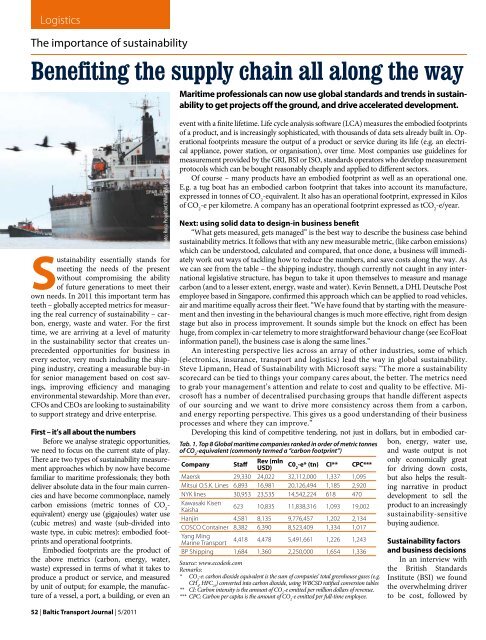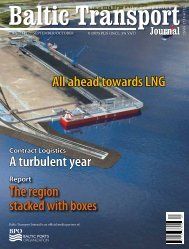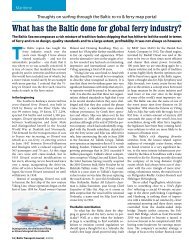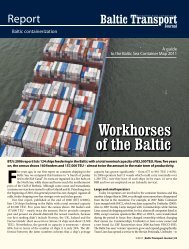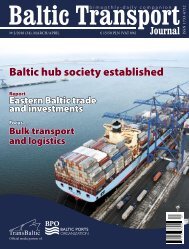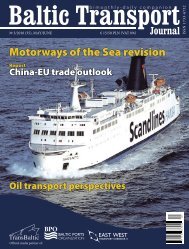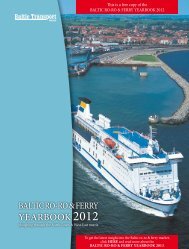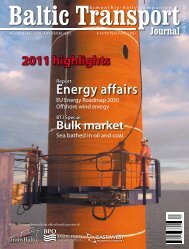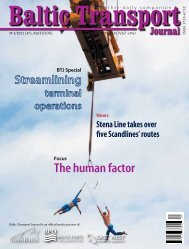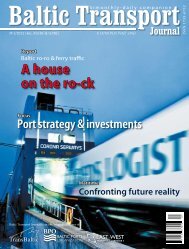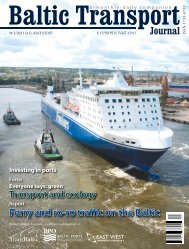BTJ 5/2011 - Baltic Press
BTJ 5/2011 - Baltic Press
BTJ 5/2011 - Baltic Press
- No tags were found...
You also want an ePaper? Increase the reach of your titles
YUMPU automatically turns print PDFs into web optimized ePapers that Google loves.
LogisticsThe importance of sustainabilityBenefiting the supply chain all along the wayMaritime professionals can now use global standards and trends in sustainabilityto get projects off the ground, and drive accelerated development.Photo: Rona Proudfoot/Wikimedia CommonsSustainability essentially stands formeeting the needs of the presentwithout compromising the abilityof future generations to meet theirown needs. In <strong>2011</strong> this important term hasteeth – globally accepted metrics for measuringthe real currency of sustainability – carbon,energy, waste and water. For the firsttime, we are arriving at a level of maturityin the sustainability sector that creates unprecedentedopportunities for business inevery sector, very much including the shippingindustry, creating a measurable buy-infor senior management based on cost savings,improving efficiency and managingenvironmental stewardship. More than ever,CFOs and CEOs are looking to sustainabilityto support strategy and drive enterprise.First – it’s all about the numbersBefore we analyse strategic opportunities,we need to focus on the current state of play.There are two types of sustainability measurementapproaches which by now have becomefamiliar to maritime professionals; they bothdeliver absolute data in the four main currenciesand have become commonplace, namelycarbon emissions (metric tonnes of CO 2-equivalent) energy use (gigajoules) water use(cubic metres) and waste (sub-divided intowaste type, in cubic metres): embodied footprintsand operational footprints.Embodied footprints are the product ofthe above metrics (carbon, energy, water,waste) expressed in terms of what it takes toproduce a product or service, and measuredby unit of output; for example, the manufactureof a vessel, a port, a building, or even anevent with a finite lifetime. Life cycle analysis software (LCA) measures the embodied footprintsof a product, and is increasingly sophisticated, with thousands of data sets already built in. Operationalfootprints measure the output of a product or service during its life (e.g. an electricalappliance, power station, or organisation), over time. Most companies use guidelines formeasurement provided by the GRI, BSI or ISO, standards operators who develop measurementprotocols which can be bought reasonably cheaply and applied to different sectors.Of course – many products have an embodied footprint as well as an operational one.E.g. a tug boat has an embodied carbon footprint that takes into account its manufacture,expressed in tonnes of CO 2-equivalent. It also has an operational footprint, expressed in Kilosof CO 2-e per kilometre. A company has an operational footprint expressed as tCO 2-e/year.Tab. 1. Top 8 Global maritime companies ranked in order of metric tonnesof CO 2-equivalent (commonly termed a “carbon footprint”)Company StaffRev (mlnUSD)C0 2-e* (tn) CI** CPC***Maersk 29,330 24,022 32,112,000 1,337 1,095Mitsui O.S.K. Lines 6,893 16,981 20,126,494 1,185 2,920NYK lines 30,953 23,535 14,542,224 618 470Kawasaki KisenKaisha623 10,835 11,838,316 1,093 19,002Hanjin 4,581 8,135 9,776,457 1,202 2,134COSCO Container 8,382 6,390 8,523,409 1,334 1,017Yang MingMarine Transport4,418 4,478 5,491,661 1,226 1,243BP Shipping 1,684 1,360 2,250,000 1,654 1,336Source: www.ecodesk.comRemarks:* CO 2-e: carbon dioxide equivalent is the sum of companies’ total greenhouse gases (e.g.CH 4, HFC 23) converted into carbon dioxide, using WBCSD ratified conversion tables** CI: Carbon intensity is the amount of CO 2-e emitted per million dollars of revenue.*** CPC: Carbon per capita is the amount of CO 2-e emitted per full-time employee.Next: using solid data to design-in business benefit“What gets measured, gets managed” is the best way to describe the business case behindsustainability metrics. It follows that with any new measurable metric, (like carbon emissions)which can be understood, calculated and compared, that once done, a business will immediatelywork out ways of tackling how to reduce the numbers, and save costs along the way. Aswe can see from the table – the shipping industry, though currently not caught in any internationallegislative structure, has begun to take it upon themselves to measure and managecarbon (and to a lesser extent, energy, waste and water). Kevin Bennett, a DHL Deutsche Postemployee based in Singapore, confirmed this approach which can be applied to road vehicles,air and maritime equally across their fleet. “We have found that by starting with the measurementand then investing in the behavioural changes is much more effective, right from designstage but also in process improvement. It sounds simple but the knock on effect has beenhuge, from complex in-car telemetry to more straightforward behaviour change (see EcoFloatinformation panel), the business case is along the same lines.”An interesting perspective lies across an array of other industries, some of which(electronics, insurance, transport and logistics) lead the way in global sustainability.Steve Lipmann, Head of Sustainability with Microsoft says: “The more a sustainabilityscorecard can be tied to things your company cares about, the better. The metrics needto grab your management’s attention and relate to cost and quality to be effective. Microsofthas a number of decentralised purchasing groups that handle different aspectsof our sourcing and we want to drive more consistency across them from a carbon,and energy reporting perspective. This gives us a good understanding of their businessprocesses and where they can improve.”Developing this kind of competitive tendering, not just in dollars, but in embodied carbon,energy, water use,and waste output is notonly economically greatfor driving down costs,but also helps the resultingnarrative in productdevelopment to sell theproduct to an increasinglysustainability-sensitivebuying audience.Sustainability factorsand business decisionsIn an interview withthe British StandardsInstitute (BSI) we foundthe overwhelming driverto be cost, followed by52 | <strong>Baltic</strong> Transport Journal | 5/<strong>2011</strong>


